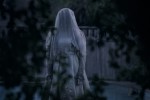“The Curse of La Llorona” is the quintessential modern horror film: simple, frightening and tedious.
Director Michael Chaves’ first foray into a big Hollywood horror franchise gives writing teachers the umpteenth example of a formulaic horror film to teach their students story structure. In a genre that often relies on stale tropes and derivative plots, “La LLorona” is just one more data point on the graph of painfully unoriginal cinema.
“La Llorona” is yet another horror film in which a supernatural force tries to take the lives of a few oh-so-innocent bystanders who get in the way. This time, the force is based on a storied piece of folklore – La Llorona, or “The Weeping Woman.” The Spanish name belongs to the crying ghost of a woman who, after being spurned by her husband, drowns her two children in a fit of rage and then follows suit in a fit of guilt.
[RELATED: Movie review: Questionable science, disconnect plot hinder horror aspect of ‘Happy Death Day 2U’]
The common Latin American folk tale has variances that change by the demography of the storyteller, but it is typically a cautionary story used by parental figures to keep their kids from staying out late at night. As the legend goes, La Llorona is forever weeping, and children wandering in the night are vulnerable to her grasp.
It’s no mistake that the film’s protagonist is a person who not only cares for her own children, but others. Child Protective Services caseworker Anna Tate-Garcia (Linda Cardellini) is the sole guardian of her son Chris (Roman Christou) and daughter Sam (Jaynee-Lynne Kinchen) after their father is killed in the line of duty as a Los Angeles police officer. She works herself ragged, as is evidenced by her boss transferring Anna’s cases to a younger, childless case worker. The audience is blasted with the subtext: This woman is here for her kids in all the ways that the antagonist La Llorona was not.
When Anna becomes a bit too involved – she loves kids, remember? – in one of her cases, she catches the ire of a mother who failed to protect her own children from La Llorona. Suddenly, Anna’s kids start to witness the mystical figure of a rotting corpse. The ghost wears a wedding dress and her touch leaves burns on the children’s arms that conveniently resemble cigarette burns. Yet, it’s only when Anna herself is burned by the spirit does she search for help elsewhere.
She seeks help from a Catholic priest, Father Perez (Tony Amendola). In case the words “franchise alert” don’t flash in front of your face, rest assured the quick black-and-white flashback of Father Perez will provide the message. In only a few frames the audience sees Perez holding the doll from the film “Annabelle,” thus weakly establishing “La Llorona” as part of The Conjuring Universe. The Warner Brothers shared cinematic universe is chock-full of genre films in which spirits try to take life from the living, as is evident in this film. It makes sense: Horror films are reliable cash machines, which is probably why all the films in this common universe have so far grossed $1.569 billion in box office earnings.
The priest is no help to Anna, but he points her to a former man of the cloth-turned-shaman named Rafael (Raymond Cruz), a curandero, or Latin American faith healer. Rafael utilizes folk remedies aplenty in his attempt to banish La Llorona from the Tate-Garcias’ lives. He only succeeds far enough to leave the audience in suspense, until the inevitably satisfying conclusion.
[RELATED: Movie review: ‘Pet Sematary’ revival falls flat, fails to deliver fully fleshed-out horror]
“La Llorona” establishes itself with all of the tropes common to movies of this caliber: creepy, lingering shots that build anticipation, unsubtly poor character choices and striking jump scares. While the technical and storytelling aspects of the film aren’t overtly amateurish, the film’s banality discloses the fact that no one involved in the production aimed to push the cinematic envelope.
If Chaves was simply trying to cut his directing teeth on a straightforward Hollywood fright fest, he accomplished his goal. But it’s a shame to call a movie like “La Llorona” a “horror” movie, as there’s not much horrifying about it. Every single frightening situation in this movie is, in fact, nothing more than a jump scare. There is no act of inhuman violence perpetuated by a complex villain, there is no examination of a classic moral conundrum and there is no mystery that ever remains even partially unsolved.
In short, there is no reason to consider “La Llorona” a stellar example of its genre, because it does not attempt to challenge the viewers’ ideas about humanity or the human condition. It spoon-feeds scares on a silver platter, but it is far from the only film to do so.
